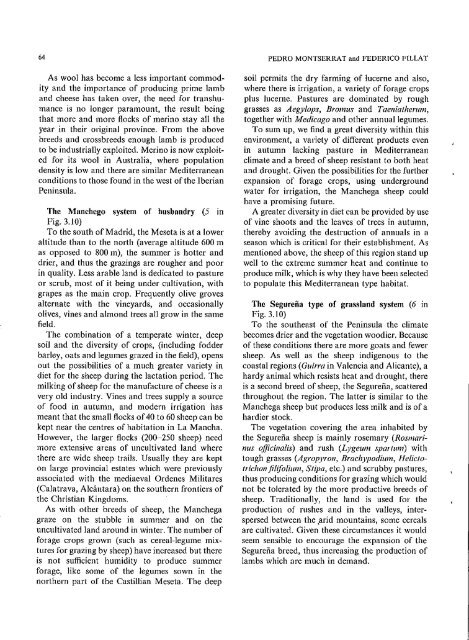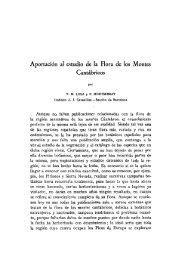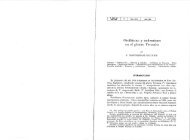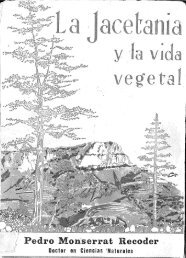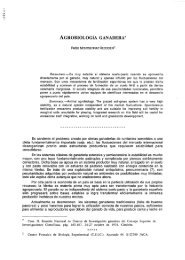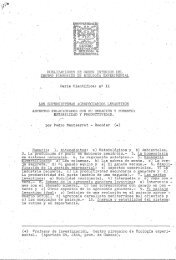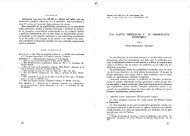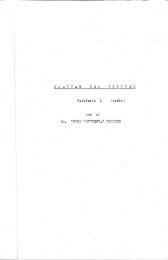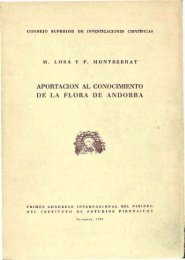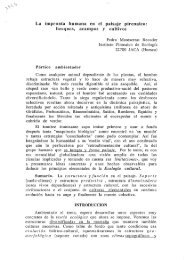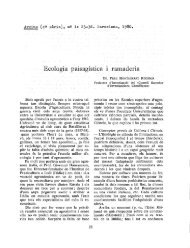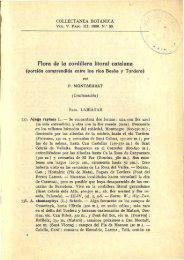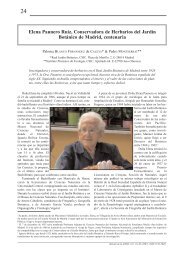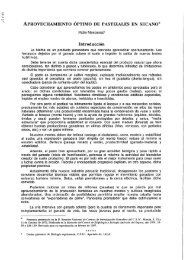the systems of grassland management in spain - Publicaciones del ...
the systems of grassland management in spain - Publicaciones del ...
the systems of grassland management in spain - Publicaciones del ...
You also want an ePaper? Increase the reach of your titles
YUMPU automatically turns print PDFs into web optimized ePapers that Google loves.
64As wooI has become a less important cornmodityand <strong>the</strong> importance <strong>of</strong> produc<strong>in</strong>g prime lamband cheese has taken over, <strong>the</strong> need for tmnshumanceis no longer pammount, lhe result be<strong>in</strong>glhal more and more flocks <strong>of</strong> mer<strong>in</strong>o slay all lheyear <strong>in</strong> <strong>the</strong>ir orig<strong>in</strong>al prov<strong>in</strong>ee. From lhe aboyebreeds and crossbreeds enough lamb is producedto be <strong>in</strong>dustrially exploited. Mer<strong>in</strong>o is now exploitedfor its wool <strong>in</strong> Auslralia, where populationdensity is low and <strong>the</strong>re are similar Mediterraneanconditions to those found <strong>in</strong> <strong>the</strong> west <strong>of</strong><strong>the</strong> IberianPen<strong>in</strong>sula.The Manchego syslem <strong>of</strong> husbandry (5 <strong>in</strong>Fig. 3.10)To <strong>the</strong> south <strong>of</strong>Madrid, <strong>the</strong> Meseta is al a loweraltitude than to <strong>the</strong> north (average altilude 600 mas opposed to 800 m), <strong>the</strong> summer is hotter anddrier, and thus lhe gmz<strong>in</strong>gs are rougher and poor<strong>in</strong> quality. Less arable land is dedicated to pastureor scrub, most <strong>of</strong> it be<strong>in</strong>g under cultivation, withgrapes as lhe ma<strong>in</strong> crop. Frequently olive grovesalternate lVith <strong>the</strong> v<strong>in</strong>eyards, and occasionallyolives, v<strong>in</strong>es and almond trees all grow <strong>in</strong> <strong>the</strong> samefield.The eomb<strong>in</strong>ation <strong>of</strong> a lemperale w<strong>in</strong>ter, deepsoil and <strong>the</strong> diversity <strong>of</strong> crops, (<strong>in</strong>clud<strong>in</strong>g fodderbarley, oats and legumes grazed <strong>in</strong> lhe field), opensout lhe possibilities <strong>of</strong> a much greater variety <strong>in</strong>diel for <strong>the</strong> sheep dur<strong>in</strong>g lhe lactation periodo Themilk<strong>in</strong>g <strong>of</strong>sheep for <strong>the</strong> manufacture <strong>of</strong> cheese is avery old <strong>in</strong>dustry. V<strong>in</strong>es and trees supply a souree<strong>of</strong> [oad <strong>in</strong> auturnl1, and modern irrigation hasmeant that <strong>the</strong> small flocks <strong>of</strong>40 to 60 sheep can bekept near <strong>the</strong> centres <strong>of</strong> habitation <strong>in</strong> La Mancha.However, <strong>the</strong> larger flocks (200-250 sheep) needmore extensive areas <strong>of</strong> uncultivated land where<strong>the</strong>re are wide sheep tmils. Usually <strong>the</strong>y are kepton large prov<strong>in</strong>cial eslates which were previouslyassociated lVith lhe mediaeval Ordenes Militares(Calatmva, Alcántara) on <strong>the</strong> sou<strong>the</strong>rn frontiers <strong>of</strong><strong>the</strong> Christian K<strong>in</strong>gdoms.As wilh olher breeds <strong>of</strong> sheep, <strong>the</strong> Manchegagraze on <strong>the</strong> stubble <strong>in</strong> summer and on <strong>the</strong>uncultivated land around <strong>in</strong> w<strong>in</strong>ter. The number <strong>of</strong>fomge crops grolVn (such as cereal-legume mixturesfor graz<strong>in</strong>g by sheep) have <strong>in</strong>creased but <strong>the</strong>r.eis not sufficient humidity lo produce summerforage, like some <strong>of</strong> lhe ¡egumes sown <strong>in</strong> <strong>the</strong>nor<strong>the</strong>rn part <strong>of</strong> <strong>the</strong> Caslillian Meseta. The deepPEDRO MONTSERRAT and FEDERICO FtLLATsoil pennits <strong>the</strong> dry farm<strong>in</strong>g <strong>of</strong> lucerne and also,where thcre is irrigation, a variety <strong>of</strong> forage eropsplus lucerne. Pastures are dom<strong>in</strong>a ted by roughgrasses as Aegylops, Bro11lus and Taenialherum,logelher lVith Medicaga and o<strong>the</strong>r annuallegumes.To sum up, we f<strong>in</strong>d a great diversity lVilh<strong>in</strong> thisenvironment, a variety <strong>of</strong> different products even<strong>in</strong> autumn lack<strong>in</strong>g pasture <strong>in</strong> Meditcrraneanclimate and a breed <strong>of</strong> sheep resislanl to both heatand drought. Given lhe possibilities for <strong>the</strong> fur<strong>the</strong>rexpansion <strong>of</strong> foragc crops, us<strong>in</strong>g undergroundwater for irrigation, <strong>the</strong> Manchega sheep couldhave a promis<strong>in</strong>g futufe.A greater diversily <strong>in</strong> diel can be provided by use<strong>of</strong> v<strong>in</strong>e shoots and <strong>the</strong> leaves <strong>of</strong> trees <strong>in</strong> autumn,<strong>the</strong>reby avoid<strong>in</strong>g <strong>the</strong> destruction <strong>of</strong> annuals <strong>in</strong> aseason which is critical for <strong>the</strong>ir establishment. Asmenlioned aboye, <strong>the</strong> sheep <strong>of</strong> this region stand upwell to <strong>the</strong> extreme summer heat and cont<strong>in</strong>ue toproduce milk, which is IVhy <strong>the</strong>y have been selectedto populate this Mediterranean type habitat.Thc Segureña type <strong>of</strong> <strong>grassland</strong> syslem (6 IIIFig.3.10)To <strong>the</strong> soulheasl <strong>of</strong> <strong>the</strong> Pen<strong>in</strong>sula <strong>the</strong> clima tebecomes drier and lhe vegetation woodier. Because<strong>of</strong> <strong>the</strong>se conditions <strong>the</strong>re are more goats and fewersheep. As well as <strong>the</strong> sheep <strong>in</strong>digenous to <strong>the</strong>coastal regions (GII!rra <strong>in</strong> Valencia and Alicante), ahardy animal which resists heat and drought, <strong>the</strong>reis a second breed <strong>of</strong> sheep, <strong>the</strong> Segureña, scalteredthroughout <strong>the</strong> region. The lalter is similar lo lheManchega sheep but produces less milk and is af ahardier slock.The vegetalion cover<strong>in</strong>g <strong>the</strong> area <strong>in</strong>habited by<strong>the</strong> Segureña sheep is ma<strong>in</strong>ly rosemary (Rosmar<strong>in</strong>llsojJic<strong>in</strong>alis) and rush (Lygell/1/ spar/llm) lVithtough grasses (AgJ'0pYI'OJl, Bl'achypodium, Helictotrichonfilifalill/1/, S/ipa, etc.) and scrubby pastures,thus produc<strong>in</strong>g conditions for graz<strong>in</strong>g which wouldnot be tolemled by lhe more productive breeds <strong>of</strong>sheep. Traditionally, <strong>the</strong> land is used for lheproduction <strong>of</strong> rushes and <strong>in</strong> lhe valleys, <strong>in</strong>terspersedbetween <strong>the</strong> .arid mounta<strong>in</strong>s, some cerealsare cultivated. Given <strong>the</strong>se circumstances it wouldseem sensible to encourage <strong>the</strong> expansion <strong>of</strong> <strong>the</strong>Segureña breed, thus <strong>in</strong>creas<strong>in</strong>g <strong>the</strong> production <strong>of</strong>lambs which are much <strong>in</strong> demando


